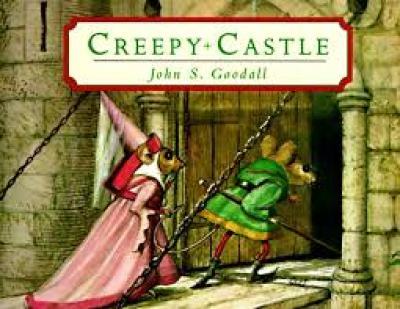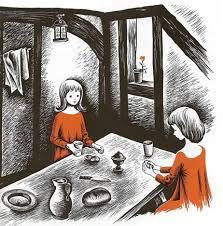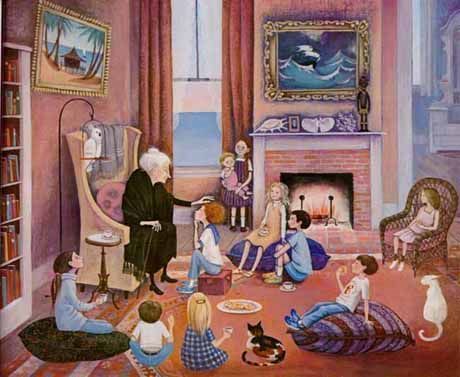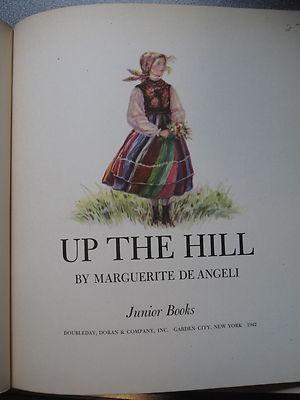Books for Christmas in the Library Project, with Amy Fahey
Titles: Various
Authors & Illustrators: Various
File Under: Children’s books, Picture books, Christmas giving
Age Group: All!
Behold, a post by my dear friend Amy Fahey, wife, mother, homeschooler, professor, writer, and keen observer of literary matters.
I always love talking about books with her. So I thought you would as well, especially for gifts as Christmas draws near.
By the way, Amy teaches at Thomas More College, where her husband, William Fahey, is president (and also teaches). As you read Amy’s delightful observations in her limpid prose here, keep in mind that she could be teaching your college student about literature and writing! Our Bridget treasures her years studying with Mrs. Dr. Fahey.
(Please note that all the Amazon links here are affiliate links — thanks!)
So without further ado, I give you Amy’s suggestions for:
Books for Children of Every Age
There is no frigate like a book
To take us lands away,
Nor any coursers like a page
Of prancing poetry.
Emily Dickinson’s words remind us of a time when reading was a common delight of both children and adults. In our day—when scores of children know as much about books as they do about coursers and frigates—I find that many young mothers simply have not heard of the authors and books that I shared with my own children just a short decade or two ago.
What were once considered “timeless classics” (many of them were Caldecott or Newbery winners) have been banished from library shelves to make room for propaganda like Feminist Baby (a board book!) and C is for Consent (described on Amazon as the “perfect gift for baby showers, toddler birthdays, and preschoolers’ home libraries”).
And many libraries didn’t simply put the classic books up for sale in the basement; they dumped them in a recycling bin. Yes, they were quite literally destroyed, and now the remaining copies of many fetch a dear price in the used book corridors of the internet.
But that is a subject for another day, since I already feel my blood pressure rising.
Today, as we continue to prepare our hearts to receive the Christ Child, I intend to introduce you to some of the books that fed my own imagination as a young mother, and delighted my children with their charming or evocative illustrations and their memorable cadence of phrase (I still think “Kuplink. Kuplank. Kuplunk” every time I see blueberries).
If you have heard of some, many, or all of them, then I am buoyed with hope. If you have not, then I still have hope that you will take up one or two of them. There are 12 days of Christmas, so if you order even a used copy from Britain in the next few days, it should arrive on time to place under your tree—and share them with your children or grandchildren.
Some of these books have been reprinted by small presses, or are still in print with the original publishers. But many of them are only available in used copies. If you are part of a St. Gregory’s Pocket or a mom’s group, you may wish to coordinate your buying of used classics, since I have found that if even one copy is purchased, the prices of the others immediately rise, sometimes precipitously, because of the insidious algorithms of the internet.
My husband and I arrived in New England, where we now make our home, over a decade ago, with four children between the ages of ten months and ten. It didn’t take me long to figure out that the land that inspired N.C. Wyeth, Howard Pyle, and Maxfield Parrish had fostered so many of the great children’s author-illustrators: Barbara Cooney, Robert McCloskey, Tasha Tudor, Virginia Lee Burton, Dahlov Ipcar (and, more recently, illustrators like Tomie De Paola, Jan Brett, Mary Azarian, and Beth Krommes, though I confess that although I find Jan Brett’s illustrations lovely, her text is often weak).
Since I don’t wish to tax your attention too greatly, I have restricted myself to only five suggestions.
Most of them are suggested authors rather than particular books, because so many of their books are so good, and you may have better luck finding one than another. And though you may be familiar with Robert McCloskey’s famous Make Way for Ducklings, you really should also have copies of Time of Wonder or Journey Cake, Ho! or Lentil or Burt Dow, Deep Water Man on your shelves.
But on to the list, which is of course necessarily, but painfully, partial. As far as age range, I guess I have in mind a child you could still hoist on your lap. But only yesterday my 9- and 12-year-old sons asked me to read a charming picture book, Robin Finds Christmas, by Molly Brett. If you don’t have this book, you should. It is a softcover published in 1961 by The Medici Society. In fact, if you find anything by The Medici Society, snatch it up. Their books are small but sturdy, with beautiful illustrations, all timeless, and published in Great Britain throughout the twentieth century.
Audrey Tarrant’s The Donkey of Nazareth is another Medici book I would love for you to share with children. And speaking of Christmas books featuring the donkey that bore Our Lady and her Divine Son (I do love the illustrations of its soft ears and large brown eyes), if you don’t have Margaret Helen Berger’s The Donkey’s Dream, you must get that too. It was recently still in print, but now, sadly, is only available in used copies.
Oh dear, I’ve gone on chatting, without starting the list. I have never been one for self-discipline when it comes to books. . . .
1. John Goodall. I’ll begin with Goodall, because he produced only wordless picture books. That’s right, none of his books have words. Instead, the story is told through half-pages that flip to reveal subtle changes. You must tell the story, and if you’ve done a good job, the child will pick up the book and tell it to himself again and again and again.
Children of all ages love these books. My grown daughters can still pore over The Story of a Castle (which traces the historical fate of a castle from its Norman origins to modern times), while younger children love The Surprise Picnic or the two books about the mischievous mouse, Naughty Nancy (to my mortification, I have to warn you to be careful when you search for this book if you do not have a filter on your computer). Here is the cover of Goodall’s Creepy Castle:

My husband warned me to buy any books I don’t yet own by John Goodall before posting this, since if you begin to purchase them, I won’t be able to afford them. I confess I did just buy his An Edwardian Christmas but decided it was worth the risk to let you have first dibs at the others—that’s how much I want you to get these books. Save them from cultural annihilation!
2. Marjorie Flack: Angus and the Ducks, Angus and the Cat, Angus Lost. Of course I’m assuming you already know the naughty little duck Ping, but if you don’t, get that first before you get the Angus books. Angus is a mischievous Scottish terrier, and these picture books, in addition to capturing that inquisitive terrier pose, also have a simple storyline that at times borders on lyrical. Here is a passage from Angus and the Ducks:
Soon the DUCKS stopped by a stone watering trough under a mulberry tree.
Angus stopped, too. Each DUCK dipped a yellow bill in the clear cool water. Angus watched. Each DUCK took a long drink of the cool clear water. Still Angus watched. Each DUCK took another long drink of the cool clear water.
Then Angus said:
WOO-OO-OOF!!!
Away the DUCKS scuttled and
Angus lapped the cool clear water.
Birds sang in the mulberry tree.
The Sun made patterns
through the leaves
over the grass.
And here is a picture of Angus:

Do you now see why you must buy this book?
Don’t even bother looking for the lesser-known Angus and Topsy or Angus and Wag-Tail—if a stray library copy does occasionally make its way into the hands of a bookseller, the price is between $50 – $500. Yes, they’re all ex-library copies. But don’t get me started again. . .
3. Barbara Cooney. For some reason, I always think of Barbara Cooney when I see this glorious night nativity scene by Geertgen tot Sint Jans:

The broad foreheads, the simple, placid expressions—these seem to be one of the hallmarks of Cooney’s characters, too. Here are two illustrations, one from her classic retelling of Chaucer’s Chanticleer and the Fox and the other from her equally famous Miss Rumphius:


If you’re looking for something Christmas-themed, you can’t go wrong with Cooney’s illustrated version of Rumer Godden’s The Story of Holly and Ivy. She also illustrated an interesting Aztec version of the nativity story, Spirit Child.
Fortunately, most of her most famous works (The Ox-Cart Man, Hattie and the Wild Waves, Island Boy, plus the aforementioned ones) are still in print. I discovered in the course of writing this post that she also illustrated an edition of Sarah Orne Jewett’s short story, A White Heron. I just bought my used copy for $12.00 on abebooks.com; the cheapest one on Amazon was $30.00. So shop around!!
(Just a note for local readers of Auntie Leila’s blog, you should know that Cooney lived in Pepperell, Massachusetts, and the Lawrence Library is featured in Miss Rumphius. If you go through town, you’ll see the large white, gated home where she lived. )
4. Munro Leaf and Robert Lawson, Ferdinand the Bull and Wee Gillis. You must have heard of Ferdinand, the bull who would rather smell flowers than fight:
He wouldn’t fight and be fierce no matter what they did. He just sat and smelled. And the Banderilleros were mad and the Picadores were madder and the Matador was so made he cried because he couldn’t show off with his cape and sword.
Here’s what the pompous matador looks like just before he cries:

(It doesn’t trouble, but rather amuses, me that Ferdinand was banned as subversive in both Spain and Nazi Germany because of its “pacifist” message.)
Our copy of Wee Gillis is inscribed to my husband by his mother, and was given to him when he was a little boy. It is one of my favorite children’s books, all in black-and-white drawings and perfectly capturing in both pictures and words the plight of a young Scottish boy caught between his relations in the highlands and those in the lowlands.

Munro Leaf was a bit of a “two hit wonder” when he collaborated with Lawson, but you would do well to stock your library with other works written or illustrated by Lawson like his tribute to ancestors, They Were Strong and Good. My children have also loved his chapter books for slightly older children like Rabbit Hill, Ben and Me, or Mr. Revere and I, or good books by others that he illustrated, like Adam of the Road and Mr. Popper’s Penguins.
5. Marguerite de Angeli. I confess my fondness for Margurite de Angeli grew exponentially when I found out that she was born and raised in my home state, Michigan.
Since 1981, the town library in Lapeer, Michigan had been named the Marguerite de Angeli Library, but sadly they stripped this award-winning author of that honor in 2007. Marguerite de Angeli wrote and illustrated books for a variety of ages, from her edition of Mother Goose rhymes for children, to her novels for older children like the The Door in the Wall and The Black Fox of Lorne (a story of tenth-century Scotland).
Her style of illustration has been compared to that of the better known Tasha Tudor. My favorite Marguerite de Angeli book is called Up the Hill, and takes us through a year in the life of a Polish immigrant girl, introducing us to her Easter and Christmas customs, and infused with her Catholic faith.

Her works about young, frequently immigrant, American children, whether Catholic, Quaker (Thee, Hannah), Amish (Henner’s Lydia), Swedish (Elin’s Amerika), German (Skippack School) or African-American (Bright April) are sensitive and heartwarming.
Some of her works have been reprinted, but those that have not (like Up the Hill) can be quite expensive in used editions. I frequently checked her works out of my local library less than a decade ago, but went in one day to find the entire collection gone. Upon inquiry, I was told by the children’s librarian that any book that had not been checked out in the last three years was on the chopping block. I protested that I had certainly checked them out within that time frame, as had at least two friends of mine.
It is hard not to feel like there is a vast conspiracy afoot (here is one Berkeley protest I would have joined: Protesters rally, check out books to make clear concerns over weeding at Berkeley Central Library.
But I don’t want to succumb to sadness, when really, there are so many good books still available, and so many interested readers like you, waiting to introduce them to children.
I’d like to tell you about so, so many others: Edward Ardizzone’s Tim books, Maj Lindman’s Ricka, Flicka, Dicka and Snipp, Snapp, Snurr series, or Lucy Fitch Perkins’ very politically incorrect but charming Twins series [I wrote about this series here — LML], Valenti Angelo’s delightful story of an Italian Catholic boyhood, Nino, the playful wordless books by Japanese illustrator Mitsumasa Anno, the fairies and gnomes of Swedish illustrator Elsa Beskow.
But probably it would be best if you started exploring some of the books suggested above and see where the search leads you.
The reality is that I didn’t know about any of these books as a young mother. I was graced to have friends, older mothers (like my mother-in-law), and seasoned children’s librarians make suggestions along the way.
In more recent years, though, the “customers who bought this also bought….” section of Amazon has displaced the library shelf as a virtual place to bump into books you may not have known about.
Tragic, is it not, that we can no longer peruse a library bookshelf in the hopes of discovering new frigates and prancing coursers for our children? But we can console ourselves with the possibility of introducing these works anew to the “rising generation,” to foster in them a sense of wonder and delight in God’s marvelous creation.
As Edmund Burke once wisely said, “To love the little platoon we belong to . . . is the first link in the series by which we proceed towards a love to our country, and to mankind.”
What better way to cultivate this love than sharing enchanting stories and pictures with your “little platoon” this Christmas?
Amy Fahey spoke at the most recent Catholic Literature Conference of the Russell Kirk Center, on The Moral Imagination; she often can be found speaking at the IHM homeschooling conferences. She and William have five highly educated children.
For other book suggestions, search all the LMLD Library posts, especially this one for your older, voracious reader. I also have ideas for Christmas gift books in this post about learning to write. (All Amazon links are affiliate links, thanks!)
What is the Like Mother, Like Daughter Library Project?
The post Books for Christmas in the Library Project, with Amy Fahey appeared first on Like Mother Like Daughter.



